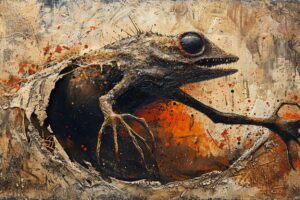Kunapipi Aboriginal Mythology: An In-Depth Exploration of the Ancient Tradition

Kunapipi is a revered deity in Australian Aboriginal mythology, believed to be the mother of all living beings. Legends tell of her transformative powers and important role in creation.
Rituals and ceremonies associated with Kunapipi endure, reflecting deep connections to nature and the cycle of life. The significance of Kunapipi in contemporary Aboriginal culture underscores the enduring legacy of this ancient tradition.
Kunapipi: The Aboriginal Deity
Kunapipi is a revered figure in Australian Aboriginal mythology, embodying the essence of creation and fertility. Exploring the origin, characteristics, and significance of Kunapipi provides insight into the rich cultural tapestry of the Aboriginal peoples.
Origin and Mythology
In Aboriginal lore, Kunapipi is believed to be the primordial mother who birthed all living beings, carrying the power to transform between male and female forms. Her mythological origins delve into the creation narrative of the Aboriginal peoples, highlighting her role as a central figure in the genesis of life.
Characteristics and Traits
- Kunapipi is revered for her transformative abilities, symbolizing the cyclical nature of life.
- Her fluidity in gender representation reflects the interconnectedness of all living beings.
- As a deity of creation, Kunapipi embodies the nurturing aspects of motherhood and the vital force of fertility.
Significance in Australian Aboriginal Culture
The presence of Kunapipi in Aboriginal culture underscores the deep reverence for the cycles of life, birth, and renewal.
Her significance transcends myth and legend, shaping the spiritual practices and beliefs of Aboriginal communities across generations.
Legends of Kunapipi
Discover the fascinating tales surrounding Kunapipi, a revered deity in Australian Aboriginal mythology, with stories passed down through generations…
The Sisters Wawalag
Learn about the pivotal role played by the Sisters Wawalag in the myths of Kunapipi, as they journey through the land and encounter the mystical forces that shape their world.
Journey to Arnhem Land
Embark on a virtual voyage to Arnhem Land alongside Kunapipi, exploring the landscapes and encountering the challenges faced by the legendary deities on their quest for knowledge and power.
Creation of Seasons and Rituals
- Uncover the secrets of how the Sisters Wawalag, in conjunction with Kunapipi, influenced the creation of the seasons through their actions and interactions with the natural world.
- Explore the ancient rituals and ceremonies that emerged as a result of the Sisters’ journey, delving into the symbolic meanings behind each tradition and its significance in Aboriginal culture.
Rituals and Ceremonies of Kunapipi
Rituals and ceremonies are integral to the worship of Kunapipi in Australian Aboriginal culture.
These sacred practices hold deep symbolism and significance, connecting the community to their spiritual beliefs and traditions.
Initiation Rites
Initiation rites play a crucial role in the Kunapipi ceremonies, marking the transition of young individuals into adulthood within the tribe. These rites are a rite of passage, symbolizing growth, maturity, and responsibility within the community.
Symbolism of Ochre and Blood
Ochre and blood hold profound symbolic meanings in Kunapipi rituals. Ochre represents the connection to the earth and the ancestors, while blood symbolizes life, vitality, and sacrifice. The use of these elements in ceremonies underscores the spiritual depth of the practices.
Sacred Sites and Traditions
Sacred sites are intricately woven into the fabric of Kunapipi ceremonies, serving as locations where the spiritual and physical worlds intersect. These sites hold special significance and are revered for their connection to the deity and the ancestral spirits.
Traditional rituals and practices are preserved and passed down through generations, ensuring the continuity of Kunapipi’s worship.
Regional Variation of Kunapipi Worship
In exploring the regional variations of Kunapipi worship, it becomes evident that the deity’s influence has been shaped by diverse factors across different Aboriginal communities:
Influence of Contact with Traders
- The interaction with traders played a crucial role in introducing new elements to Kunapipi worship.
- Trade routes brought cultural exchange and the incorporation of external beliefs into the existing Aboriginal practices.
- This contact influenced the rituals and ceremonies associated with Kunapipi, paving the way for adaptation and evolution.
Continuity of Rituals in Different Tribes
- Despite regional diversity, the core rituals related to Kunapipi have shown remarkable continuity over time.
- Various tribes have preserved ancient traditions and passed down ceremonial practices from generation to generation.
- This continuity underscores the enduring significance of Kunapipi in Aboriginal culture.
Role of Kunapipi in Different Aboriginal Communities
- Kunapipi’s role varies across different Aboriginal communities, adapting to local beliefs and customs.
- Some communities emphasize Kunapipi as a symbol of fertility and creation, while others focus on her transformative nature.
- Understanding these diverse roles sheds light on the multifaceted significance of Kunapipi in Aboriginal spirituality.
Kunapipi in Contemporary Aboriginal Culture
Kunapipi’s presence remains integral to contemporary Aboriginal culture, reflecting ongoing adaptations, evolutions, and sustained relevance.
The deity’s enduring importance speaks to the tradition’s preserved essence.
Adaptations and Evolutions
In modern Aboriginal culture, Kunapipi undergoes adaptations and evolutions adapting to contemporary contexts. These changes reflect the deity’s enduring relevance within evolving cultural frameworks.
Relevance and Importance Today
- The significance of Kunapipi extends to modern Aboriginal communities, emphasizing the deity’s continued importance in spiritual practices and cultural identity.
- Kunapipi’s teachings and symbolism resonate within contemporary Aboriginal contexts, fostering a sense of connection to traditional beliefs.
- Amid societal changes, Kunapipi’s relevance endures, shaping understanding of spirituality and cultural heritage in Aboriginal communities.
Preservation of Kunapipi Tradition
The preservation of Kunapipi’s tradition is paramount, ensuring the deity’s teachings and rituals persist across generations.
Aboriginal communities strive to maintain the essence of Kunapipi’s legacy through ongoing cultural practices and ceremonies.
Analysis of Kunapipi Ceremonies
The analysis of Kunapipi ceremonies provides insight into the deep-rooted symbolism and spiritual significance within Aboriginal religion. Fertility plays a central role in the rituals, representing the continuity and abundance of life.
Fertility Symbolism in Aboriginal Religion
- The concept of fertility in Aboriginal religion symbolizes…
- It is a representation of…
- This symbolism is interconnected with…
Mother of Fertility Concept
- The Mother of Fertility concept refers to…
- It embodies…
- This concept elucidates…
Kunapipi’s Role in the Cycle of Life
- Kunapipi’s role in the cycle of life highlights…
- She is instrumental in…
- This role demonstrates…
Scholarly Perspective on Kunapipi
Kunapipi’s significance in Australian Aboriginal mythology has attracted scholarly attention, with researchers delving into various aspects of this ancient deity. Specifically, Ronald M. Berndt’s research has shed light on the complexities of Kunapipi’s role in Aboriginal culture.
Ronald M. Berndt’s Research
Ronald M. Berndt, a prominent scholar in the field of Aboriginal studies, dedicated extensive research to understanding Kunapipi’s influence on Australian Aboriginal belief systems. Through meticulous documentation and analysis, Berndt highlighted the nuanced layers of Kunapipi’s mythology.
Theoretical Framework of Kunapipi Studies
- Berndt’s theoretical framework emphasized the interconnectedness of Kunapipi with fertility rites, seasonal transitions, and cosmic symbolism.
- His studies explored the symbolic representations of Kunapipi’s gender fluidity and transformative nature, linking these aspects to broader spiritual concepts within Aboriginal traditions.
Contribution to Understanding Australian Aboriginal Mythology
Berndt’s contributions to the understanding of Australian Aboriginal mythology through Kunapipi’s lens have paved the way for deeper insights into the cultural and spiritual significance of this revered deity.
His research has served as a foundational resource for scholars seeking to unravel the complexities of Kunapipi’s role in Aboriginal cosmology.
.





















